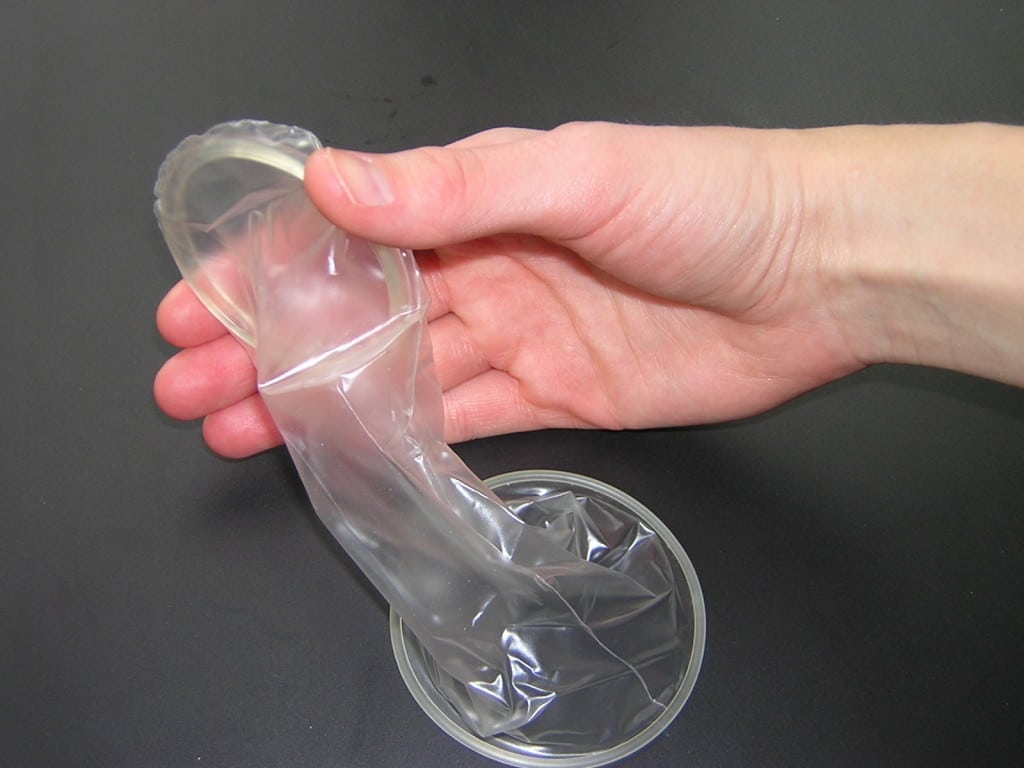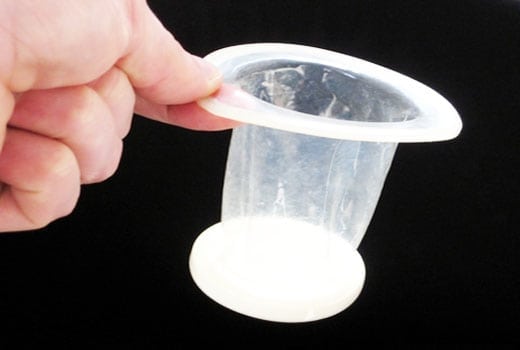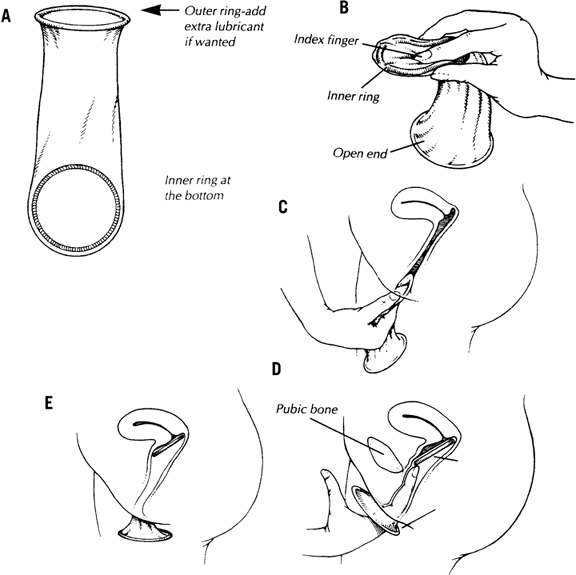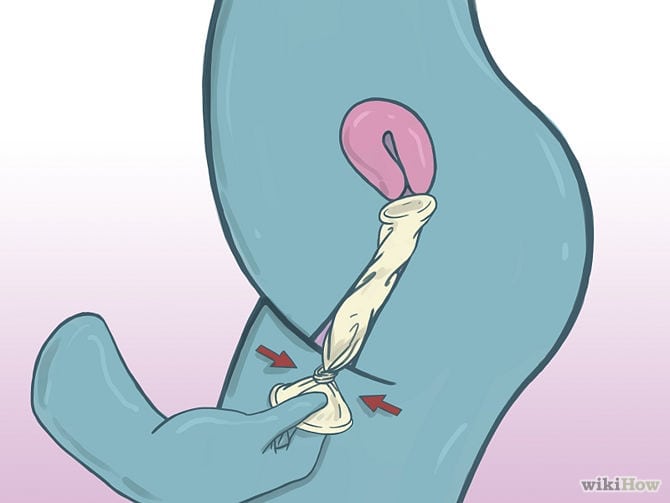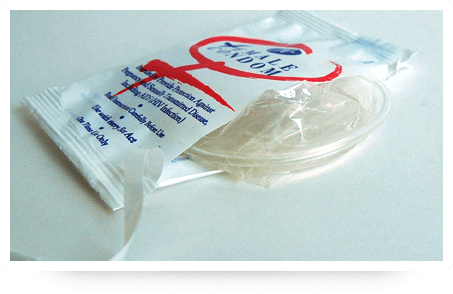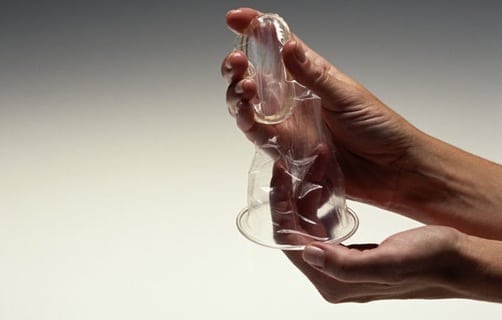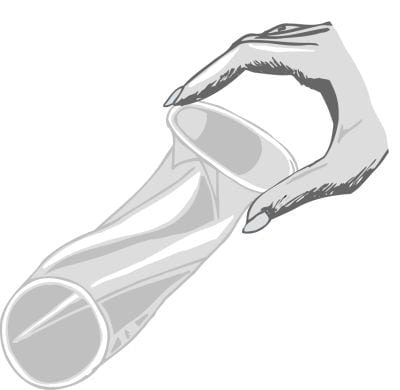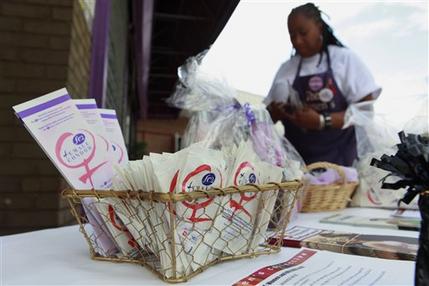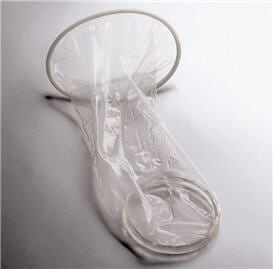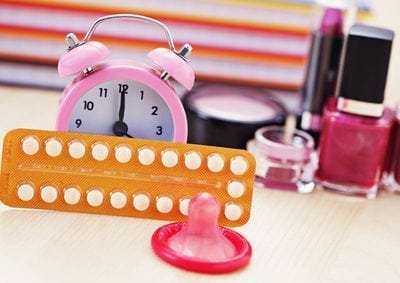Birth Control 101 is a multi-part series covering everything you need to know about birth control. It has all the details you need to make the best decision for your body, like how each method works, the pros and cons, effectiveness, cost and where to get them. After we’re done, you’ll basically be an expert, and you’ll definitely be able to make an informed decision about how to stay safe when you’re having sex.
This segment covers everything you need to know about female condoms, the awesome alternative to male condoms.
Check out our Birth Control 101 section for details on every birth control method, and Birth Control Basics for a quick and dirty overview.
Female Condoms
What are they?
Female condoms, like male condoms, are a barrier method of birth control that also protect against STDs, some STIs, and HIV. Unlike male condoms, which are typically made of latex, female condoms are made of a thin plastic called polyurethane or a thin synthetic rubber called nitrile. Some may contain spermicide (to kill sperm) or lubricant (to keep sex smooth). They are shaped kind of like a deflated elephant’s truck, and are worn inside the vagina during sex.
Unlike male condoms, female condoms do not come in a variety of sizes, styles, colors, and flavors… and they don’t have tons of photos with sexy models showing them off. But, they’re still pretty awesome, and put the power in your hands to take control of your health and safety. They are not as common as male condoms, but are sometimes preferred, as they are often much more comfortable than male condoms with the same protection.
How do they work?
Female condoms work the same way male condoms do, except they are inserted into the vagina instead of rolled over the penis. It is a pouch that is open at one end and closed at the other, with a flexible ring at both ends to keep the condom inside the vagina. They prevent body fluids from mixing and sperm from entreating the vagina during sex. This prevents pregnancy and protects both partners against STD’s and HIV, as no bodily fluids are mixing at all. It also protects against STIs, except for those that are transmitted via skin-to-skin contact (like herpes). Unlike hormonal birth control methods, female condoms must be used properly every time you have sex in order to be the most effective.
How to Insert a Female Condom
- Before you even open the condom, make sure to check the inspiration date. Expired condoms can be thin, brittle, and dry – and are much more likely to break. Also make sure that the wrapper does not look damaged, with any tears or holes.
- Open the wrapper gently and cleanly along one end, making sure not to damage the condom inside. If the condom looks torn, brittle, dry, stiff, sticky, or otherwise messed up – get rid of it, and use another.
- Put the condom on way before your partner’s penis gets anywhere near your vagina. This will be the most effective in preventing the exchange of bodily fluids, and keeping his pre-cum totally away from your lady bits.
- The condom will be compressed, with two rings at each end. Using your finger, before putting it on, gently unroll it a teeny tiny bit to figure out which end is the closed end, and which is the open end. The closed end will be inserted into your vagina.
- Many condoms come lubricated, but if not (or even if it does), it’s a good idea to put a drop or two of lube on the outside of the closed end to help the condom slide in. You can also put some lube on the inside to give additional sensation to your partner. You can even use spermicide for some extra protection.
- Find a comfortable position to insert the condom, as you would when putting in a tampon. You might want to stand with one foot on a chair, sit on the edge, lie down, squat, or whatever position is most comfortable for you.
- Hold the closed end and squeeze both sides of the ring together. Then, insert it like a tampon, pushing the inner ring as far up into your vagina as it will go.
- Pull your finger out. The outer ring will hang about an inch outside your vagina. It does look a little weird, but don’t try to tuck it in. Tucking it in could cause your partner to slip outside of the condom, and reduce its effectiveness.
- Remember, using a male condom with a female condom will not double your protection. It will actually create more friction, and encouraging tearing or breaking.
How to Remove a Female Condom
- Amazingly, with female condoms, it doesn’t matter if your partner goes soft inside you. So, whenever you’re finished, just squeeze the outer ring and twist it closed so the semen doesn’t spill out.
- Gently pull the condom out, using gravity to your advantage so that no semen spills.
- Throw the condom away in a trash can. Feel free to wrap it up with a tissue for everyone’s happiness. But, don’t flush condoms down the toilet! It’s really bad for the water supply, the environment, and your plumbing.
- When you’re ready to go again, make sure to use a brand new condom. Also make sure that he washes his penis with soap and water before your next session.
What to Do if a Condom Breaks
If your female condom breaks, you’ll probably be able to tell. The process is generally the same as if the male condom breaks. If it breaks, stop having sex and replace the condom. If semen comes in contact with your vagina, you’ll need to take some extra precautions. First, wash it away with soap and water. Then, use some spermicide if you have it handy. Finally, check out some emergency contraception options if you’re not on a back-up birth control. Emergency contraception can be used to prevent pregnancy up to five days after unprotected sex – but the sooner you use it, the more effective it will be. If you’re concerned about STDs or STIs, head to your gynecologist for an examination.
It’s totally normal for the female condom to move from side to side during intercourse. But, if your partner “slips around” the condom accidentally and makes contact with your vagina, or if the outer ring is pushed inside the vagina, you should stop having sex and fix it. As long as your partner’s semen hasn’t made contact with your vagina, you can gently remove the condom and re-insert it. If your partner’s semen has made contact with your vagina, follow the same guidelines above to prevent pregnancy.
Effectiveness
When female condoms are used perfectly, they are 95% effective. When used typically (imperfectly), they are only 79% effective.
Pros
- Female condoms are a great alternative to male condoms, giving women more control over their safety and health, as well as freedom from worry.
- They are simple, fairly effective, relatively cheap, and somewhat easy to find. There is no prescription or fitting needed.
- Male and female condoms are the only birth control methods that also protect against STDs, HIV, and some STIs.
- They can also be used as a “back up” method of birth control for extra protection.
- Condoms are easy to use, store, and remember. They are also easy to carry and disposable.
- There are virtually no side effects. For those who are allergic or sensitive to latex condoms, female condoms are a great alternative.
- Condoms can help with premature ejaculation. If your partner is at the finish line before the race even starts, they will help him to last longer.
- If your partner complains that male condoms are uncomfortable or desensitizing, female condoms are the perfect alternative to still protect against STDs, HIV, and STIs.
- Female condoms can be used with water, silicone, and oil based lubes.
- The outer ring can give you additional stimulation, since it rubs against your clitoris during intercourse!
- The female condom stays in place even if your partner goes soft, and can be re-inserted if he slips around it.
Cons
- Female condoms are not a very common method of birth control, so it may seem a little weird at first, and definitely takes some getting used to. You have to make sure to use them correctly each and every time in order for them to be effective. It may take some practice to get comfortable with the method and use it correctly. So, it’s a good idea to give them a test run, and try them out first before you’re in the heat of the moment.
- As with all barrier methods of birth control, there may be a bit of discomfort during insertion or wear. You have to get up close and personal with your vagina in order to insert it, and it might be a bit uncomfortable or cause irritation during wear.
- Guys may still complain about a loss of sensation, although the feeling is significantly better for guys when using female condoms over male condoms.
- Condoms provide the best protection against STDs, HIV, and STIs, but the protection is not perfect. Herpes, syphilis, chancroid, HPV, and other STIs can be transmitted via skin to skin contact, which is not necessarily covered by the condom. Always be sure to protect yourself, especially with a new partner.
- Condoms are often used improperly – allowing semen to get inside the vagina. Be careful not to tear, rip, or break the condom – and also make sure not to spill anything out during removal. If your partner slips outside of the condom and makes contact with your vagina, make sure to re-insert the condom properly before continuing. User error is the biggest reason why condoms can be ineffective. If takes an effort to use them right every time – but it’s totally worth it.
- Oddly enough, female condoms can make squeaky or rustling noises during intercourse, since it is kind of life a soft plastic baggie just hanging out inside you. Lubes can help to decrease the noise, but it’s kind of just something you’ll have to deal with.
Cost
A bit more expensive than male condoms, but around the same price when bought online. About $5 for a 3-pack, $12 for a 10-pack, and free at Planned Parenthood, health departments, or your school’s health center!
Where to Get Them
You can purchase female condoms over the counter at your local pharmacy, drugstore, or grocery store. A limited selection is also available for free at Planned Parented, health departments, and your school’s health center.
P.S. Let’s Break the Gender Bias
Slutty Girl Problem is on an unofficial mission to make female condoms just as sexy as male condoms, if not more. Searching through photos of “male” vs. “female” condoms showed us that there is a total gender bias going on with this awesome birth control method. Why are sexy models posing with male condoms, while female condoms are shown deflated, droopy, and in poor lighting – essentially like a used and discarded male condom? We want to show that female condoms are not only awesome and effective, but can totally make heads turn, too.
So, send us some creative snap shots of female condoms. Whether you’re posing with them, placing them with objects, or simply designing with them in creative ways… let’s make a change and finally make female condoms sexy! Our favorite snap shots may be used in this post, a new featured post, or blasted across our social media! Send submissions to [email protected] – no pornographic photos!
Don’t stop there… learn more about the other methods so you can find the perfect fit! Check out these articles in our Birth Control 101 series.
Birth Control 101: The Basics of Birth Control
Birth Control 101: The Pill
Birth Control 101: The Patch
Birth Control 101: The Ring
Birth Control 101: The Shot
Birth Control 101: The Implant
Birth Control 101: Hormonal and Copper IUDs
Birth Control 101: Male Condoms
Birth Control 101: Cervical Cap
Birth Control 101: Diaphragm
Birth Control 101: The Sponge
Birth Control 101: Spermicide
Birth Control 101: Pull Out Method
Birth Control 101: Emergency Contraception (Plan B)
Common Birth Control Myths
Sources “Birth Control Methods.” Bedsider Birth Control Support Network. Bedsider, n.d. Web. 27 July 2013.
“Birth Control Methods.” Planned Parenthood. Planned Parenthood Federation of America, 2013. Web. 27 Jul. 2013.
“The Ultimate Guide to Safer Sex.” Greatist, n.d. Web. 27 July 2013.
“Types of Contraception.” Advocates for Youth, 17 Jan. 2012. Web. 27 July 2013.
